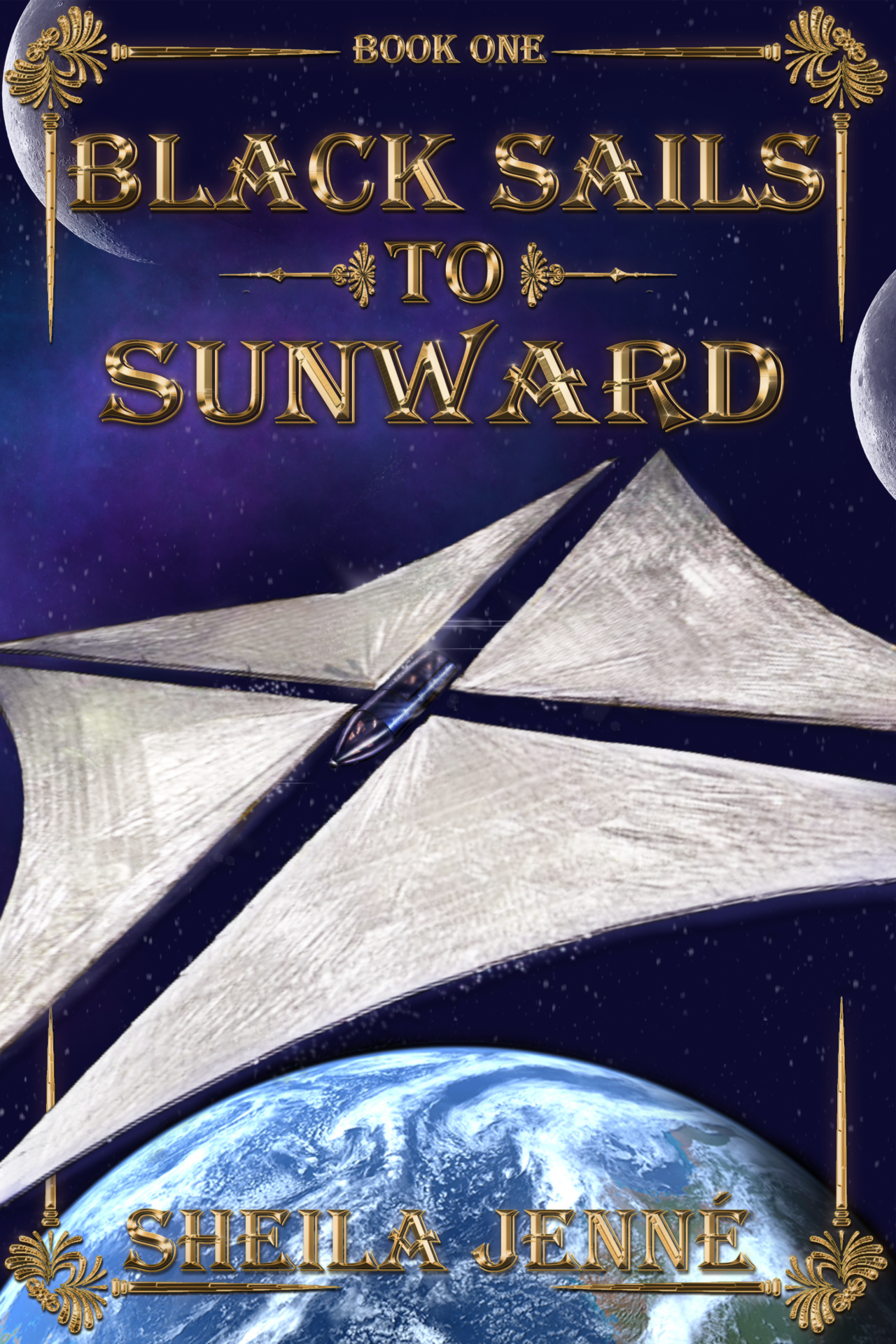
Sheila Jenne is joining us today to talk about her novel, Black Sails to Sunward. Here’s the publisher’s description:
In a world of frock coats, solar sails, and rigid class boundaries, Lucy joins the Martian Imperial Navy as a midshipman. Mars and Earth are at war, and Lucy hopes for quick promotion. But when she arrives aboard ship, she finds her childhood ex-friend, Moira, already there. Class differences got in the way of their budding romance five years ago, and both of them are nursing grudges.
Those same class differences are threatening the ship, as the enlisted spacers threaten a mutiny and Lucy is forced to support the abusive officers. When Moira becomes a pirate, taking Lucy captive, the tables are turned. Lucy now has to rely on her enemy for her life.
Her oath as an officer forbids her from helping the pirates, but it’s becoming obvious that the Martian Empire doesn’t deserve her loyalty. If she throws in her lot with the pirates, her family is doomed to poverty, but it could give her a chance to reconcile with Moira and claim the love she rejected so long ago.
What’s Sheila’s favorite bit?

Sheila Jenne
There were two main things I wanted when I began writing Black Sails to Sunward. First was that I wanted it to be in space and use the hardest science I could manage. Second was that I wanted it to feel like an old timey sailing ship. Everything from officers in tailcoats to cutlass battles to pirates. I wanted that mood, and I wanted it to happen in space.
Space travel as it’s usually depicted, though, is far too clean and safe. The Enterprise has wall-to-wall carpet and chocolate mousse. I wanted something rougher: months out of contact from home, bad food, the dark spaces below decks. But how would I make that happen? Surely with good enough tech to be out in space at all, people would find a way to be comfortable!
I tossed around a few ideas in my mind, and then it finally came to me: ban electricity. Take electricity out of the picture, and the spaceships came into focus: metal outside and wooden decking within, reeking algae tanks to create oxygen and ward off scurvy, specialized hammocks strung between rows of cannon. Given a lack of electricity, what technology could my space navy use instead?
Of course the ships had to be sailing ships. Not some made-up technology, but the real phenomenon of driving a sail with the force of the sun. The Japanese space agency, JAXA, has sent a solar sail all the way to Venus! To keep the vibe, I used as much traditional sailing terminology as possible: mainsail, forecastle, jib, and reef.
I took gravity away—no way to make it, with the tech they have, and far too comfortable anyway. That gave them a chance to spar with swords in an entirely new way.
For some things, like circulating air around the ship, they use crank power. Just wind up a spring and the fan goes for some time before it runs out. As you can imagine, the ships need a large amount of manpower to keep running, just as old sailing ships did. Pumping waste water, deploying the sails, and hauling them about for a change of course are all done with pure manpower.
For a very few things, the government has made an exception to the anti-electric laws: the batteries in space suits and long-distance radio messages. But computing is still an absolute no, so messages are sent and received by hand, by a human operator. That means every one of my characters’ messages passes through hostile hands. They have to resort to clever tricks to encrypt them well enough to hide their tracks.
Navigation is one chore you can’t easily substitute with a crank. Today, it takes no small amount of computer power to figure out where a spaceship is at any given time, as well as radio contact with Earth or its satellites. And I’d already said computers were right out—my Martians are far too worried about artificial intelligence to use even the simplest calculator.
Thanks to Lady Astronaut, though, I knew the work could be done with a sextant—somehow. That set me off on a quest through history, math, and naval history to find the answer of how you’d actually do it.
I was lucky enough to meet an expert in celestial navigation who teaches modern-day sailors how to steer by the stars. I picked her brain about it for over an hour, completely neglecting everyone else at the party, and she explained how it works. You measure the angle between a star—any star you can recognize—and the horizon. Combine that with the exact time and the place the star should be at that time, and you know where you are. In case of doubt, you can take another sighting off a second star.
However, in space you don’t have a horizon. You can very easily work out what direction your ship is pointed by the stars, but none of that will tell you where your ship is. The stars are so far away that, no matter where you are in the solar system, the view of the stars you get is exactly the same.
I was stumped for months and even ripped that part of my book out. Maybe if I was vague enough, nobody would notice I hadn’t been able to verify the math.
But I realized eventually that the planets, unlike the stars themselves, move around quite a lot. Their arrangement from your spaceship tells you everything you need about where you are. You don’t even need to use the method sailors did. Instead, you can fix your point using the “lighthouse problem” in trigonometry. This is a problem where a sailor could find out how far they were from shore by the angular distance between two lighthouses. In space, since you travel in three dimensions, you’d need three planets. But once you have them, you can find your location with simple trig functions.
Of course they still don’t have calculators to help. So navigation is the task of the best mathematicians in the Martian Navy. Can you blame my main character for thinking she’s special for being able to do it?
Now that my book is out in the world, I suspect most readers will pick it up for the space adventures, for the swordfighting, for the Regency outfits, or for the romance side plot. I don’t think anybody will care that much that I carefully checked the math and that every invention I created would actually work. But it was great fun puzzling over the problems I’d made for myself. That’s why my worldbuilding is my favorite bit.
LINKS:
Black Sails to Sunward universal book link
BIO:
Sheila Jenné was raised on Star Trek and classic novels of the Age of Sail. But instead of joining the Navy like her dad wanted, she ended up a Latin teacher, content writer, and mother of four. When she isn’t writing, she enjoys historical costuming, fiber crafts, and hiking.
